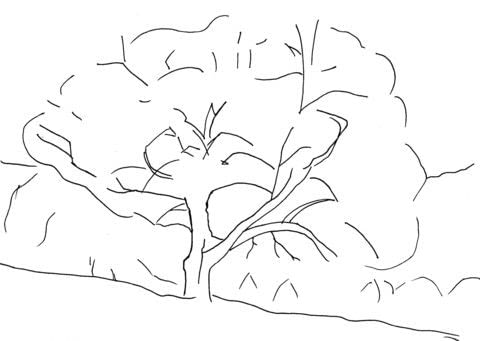https://www.cutoutandkeep.net/projects/spring-landscape-greeting-card • Posted by Kelly E.
Masking fluid is a rubbery fluid that protects watercolor paper from paint. Before an artist begins to paint, it is applied to watercolor paper on any area that needs to stay white. In this tutorial you will see how masking fluid is a watercolor artist’s secret weapon. We will use it to create a painting of a flowering tree in a spring landscape. We’ll start with a simple line drawing, apply masking fluid to create flowers, and paint the background and trunk before revealing crisp white blooms. And if you would like to paint multiple trees, you’ll see how easy it is to develop variations on this tree to suit your color preferences. Magnolia? Red bud? Apple? Forsythia? The choice is yours. This tutorial was created to demonstrate how to make homemade greeting cards, but obviously you can paint your tree on regular watercolor paper and keep it for yourself!




Masking fluid is a rubbery fluid that protects watercolor paper from paint. Before an artist begins to paint, it is applied to watercolor paper on any area that needs to stay white. In this tutorial you will see how masking fluid is a watercolor artist’s secret weapon. We will use it to create a painting of a flowering tree in a spring landscape. We’ll start with a simple line drawing, apply masking fluid to create flowers, and paint the background and trunk before revealing crisp white blooms. And if you would like to paint multiple trees, you’ll see how easy it is to develop variations on this tree to suit your color preferences. Magnolia? Red bud? Apple? Forsythia? The choice is yours. This tutorial was created to demonstrate how to make homemade greeting cards, but obviously you can paint your tree on regular watercolor paper and keep it for yourself!
Watch the video tutorial

REFERENCE PHOTO: In this lesson, you’ll use a watercolor card to create a beautiful spring landscape.

Masking fluid will do a lot of the heavy lifting in this painting of a flowering apple tree. We will start out loose and finish with some small, natural-looking details. Unfold your card and tape it to a board (wooden, cardboard, foamcore, etc). Go all the way around and apply gentle pressure to the tape. You’ll be using quite a bit of water as you paint, and this will keep the card from warping.

Look at the reference photo, and draw a light pencil outline of the basic shapes you see in the tree. Pay attention to the major limbs and branches you see. This will create a sort of tree skeleton. Use the template if you wish. Also draw a slightly tilted line where the grass meets the trees in the distance, along with a horizon line.

Use an old paintbrush you don’t mind ruining (or the wooden end of a brush or similar item) to apply the masking fluid to the tree wherever you see white blossoms. Try to have a variety of sizes and shapes, ranging from specks to blobs, and cluster them together where the tree is whitest. Let this dry (10 minutes or so; it’ll feel slightly tacky when dry).

Paint the sky a light cerulean blue with cyan or other more intense blue near the top of the picture. The grassy area is yellow-green (more yellow than green), and the background hills are a warm blue (such as ultramarine). Add more green to this color the closer you get to the grassy area. Give this some time to dry.

Mix violet (dioxazine mauve) and dark brown (sepia) for the trunk, limbs, and branches. Paint these over the top of the masking fluid if you wish. Everything that has masking fluid on it will eventually become white apple blossoms. Use your tree skeleton as a guide, and don’t be afraid to simplify.

Paint the shadowy area under the trees in the distance on the left side a dark green, such as hooker’s green. Add some of this to the pine trees on the left side, too.

Mix a spring green (mostly yellow with a bit of green or blue) for the baby leaves of the apple tree. Use the tip of a small round brush to dot it in the gaps between the masking fluid. Make sure you leave some holes where the sky can show through.

Using dark green, add some shadowy leaves in and around the spring green ones. Add some extra branches where you see them happening. Let this dry.

Remove the masking fluid with a rubber cement pick-up or eraser to reveal the white apple blossoms.

Use a messed-up brush to add small, random green dots and other textures to the trees in the distance. You can also use it to blur some of the crisp borders created by the masking fluid, and the fuzzy brush can give the pine trees in the distance a little more character.

When it’s dry, remove the tape and fold the card.

Optional: add color for different kinds of trees. Pink = magnolia, magenta/purple = red bud, yellow = forsythia.